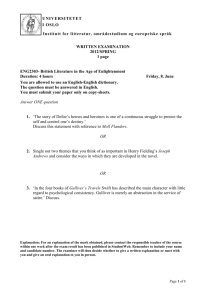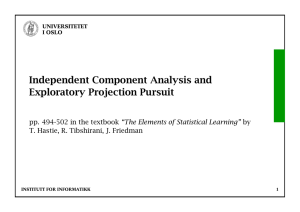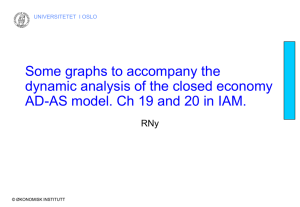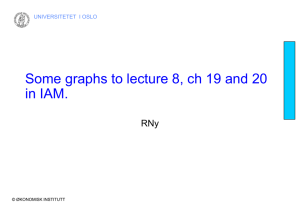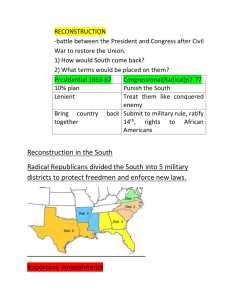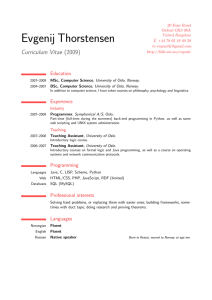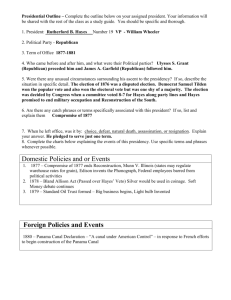Signal modelling using linear dynamical systems (Chap. 4)
advertisement
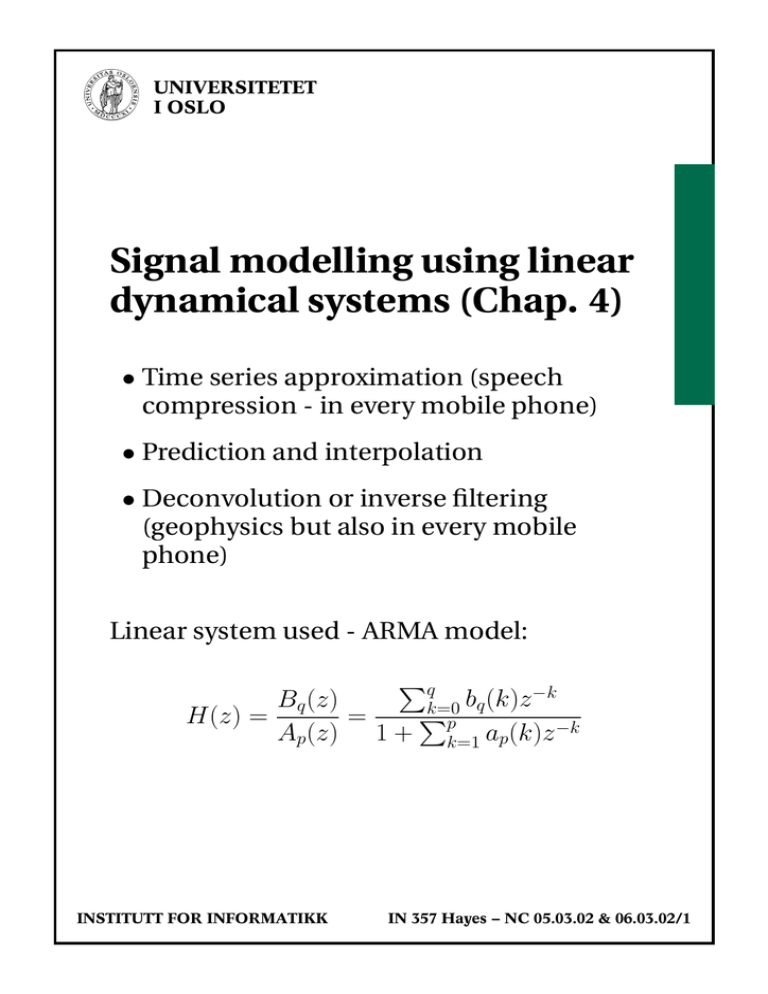
UNIVERSITETET I OSLO Signal modelling using linear dynamical systems (Chap. 4) • Time series approximation (speech compression - in every mobile phone) • Prediction and interpolation • Deconvolution or inverse filtering (geophysics but also in every mobile phone) Linear system used - ARMA model: Pq −k b (k)z Bq (z) q k=0 P = H(z) = Ap(z) 1 + pk=1 ap(k)z −k INSTITUTT FOR INFORMATIKK IN 357 Hayes − NC 05.03.02 & 06.03.02/1 UNIVERSITETET I OSLO First problem - Approximate a given time series x(n), n = 0, 1, · · · by the impulse response h(n) of the system H(z). We have: h(n) + p X ap(k)h(n − k) = bq (n) k=1 h(n), bq (n) = 0, n < 0 and bq (n) = 0, n > q Given e0(n) = x(n) − h(n), find ap(k), k = 1, · · · , p and bq (k), k = 0, · · · , q to minimize ELS = ∞ X |e0(n)|2 n=0 Leads to non-linear problem in ap(k) and bq (k) (p. 132 - 133). Three linear suboptimal solutions considered: Padé, Prony, and Shank. INSTITUTT FOR INFORMATIKK IN 357 Hayes − NC 05.03.02 & 06.03.02/2 UNIVERSITETET I OSLO Note: • h(n) is the solution of a linear difference equation ⇒ approximation basically constrained to sum of (complex) exponential sequences • Selection of model order (p and q) not treated in any detail • Statistical properties of estimators not considered Main idea behind suboptimal methods: Assume that x(n) (approximately) is the impulse response of a linear system. Then there must be a structure (more or less) given by: x(n) + p X ap(k)x(n − k) = bq (n), x(n) = 0, n < 0 k=1 for some ap(k), k = 1, · · · , p and bq (n), n = 0, · · · , q INSTITUTT FOR INFORMATIKK IN 357 Hayes − NC 05.03.02 & 06.03.02/3 UNIVERSITETET I OSLO Padé: Seeks an exact fit to a difference equation for n = 0, · · · , p + q 1. Fix p, q 2. Determine ap(k), k = 1, · · · , p from the constraint x(n)+ p X ap(k)x(n−k) = 0, n = q+1, · · · , q+p k=1 This gives p linear equations with p unknowns. Go to 1. if equations are poorly conditioned (p should be reduced). 3. With ap(k) given, determine bq (n), n = 0, · · · , q from bq (n) = x(n) + p X ap(k)x(n − k) k=1 4. Check fit for n > q + p and possibly go to 1. INSTITUTT FOR INFORMATIKK IN 357 Hayes − NC 05.03.02 & 06.03.02/4 UNIVERSITETET I OSLO Prony: Seeks an exact fit to a difference equation for n = 0, · · · , q and a least squares fit for n > q. 1. Fix p, q 2. Determine ap(k), k = 1, · · · , p by minimizing Ep,q = ∞ X (e(n))2, e(n) = x(n)+ n=q+1 p X ap(k)x(n−k) k=1 Gives a linear least squares problem in ap(k). Go to 1. if equations are poorly conditioned (p should be reduced). 3. With ap(k) given, determine bq (n), n = 0, · · · , q as for Padé bq (n) = x(n) + p X ap(k)x(n − k) k=1 4. Check min. Ep,q (Hayes eq. 4.44) and possibly go to 1. INSTITUTT FOR INFORMATIKK IN 357 Hayes − NC 05.03.02 & 06.03.02/5 UNIVERSITETET I OSLO Shanks: Performs a least squares fit to a difference equation for n > 0 but in two steps 1. Fix p, q 2. Determine ap(k), k = 1, · · · , p as for Prony, i.e. by a least squares fit over n > q 3. With ap(k) given, determine bq (n), n = 0, · · · , q by (Fig. 4.11) (a) Compute the impulse response g(n) for 1 Ap (z) , i.e. g(n) + p X k=1 (b) Minimize Es = where ap(k)g(n − k) = δ(n) P∞ 0 2 n=0 (e (n)) e0(n) = x(n)− x̂(n) = x(n)− w.r.t. bq q X bq (l)g(n−l) l=0 4. Check min. Es (Hayes eq. 4.67) and possibly go to 1. INSTITUTT FOR INFORMATIKK IN 357 Hayes − NC 05.03.02 & 06.03.02/6
